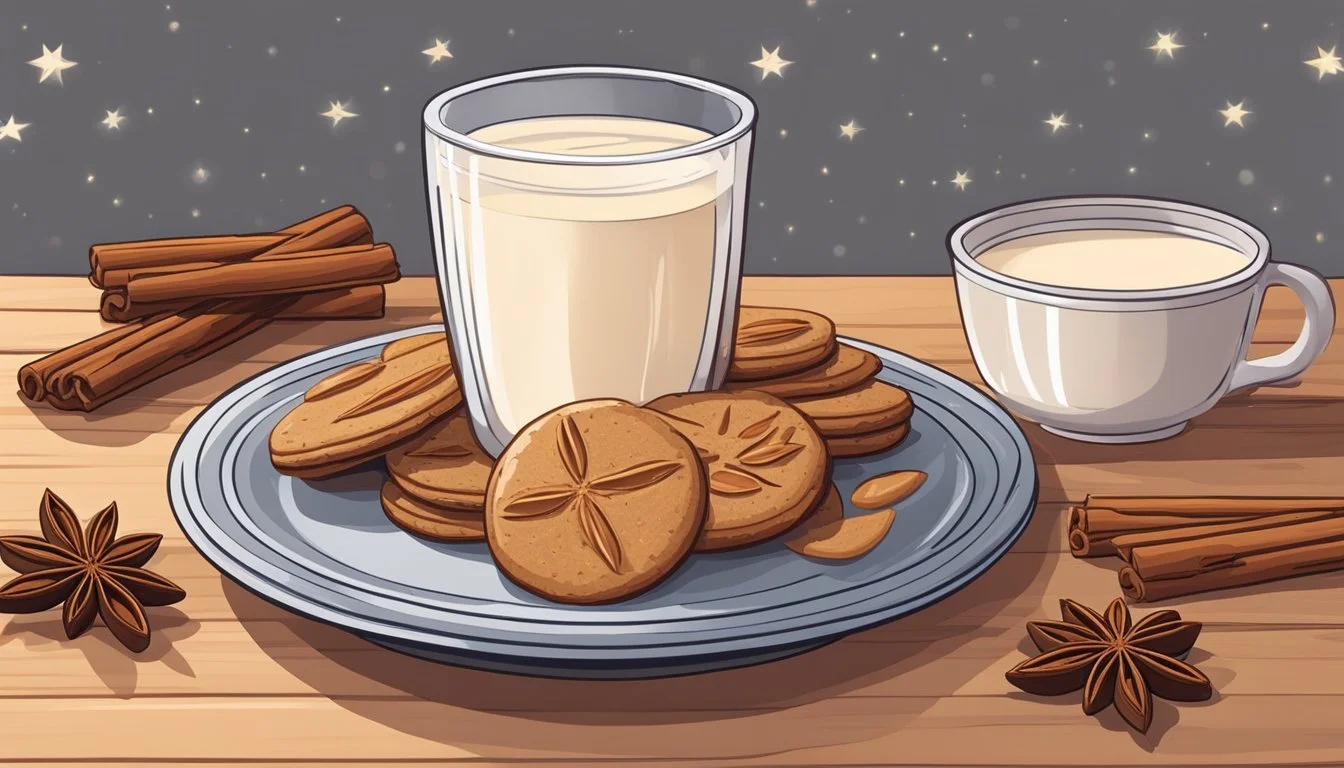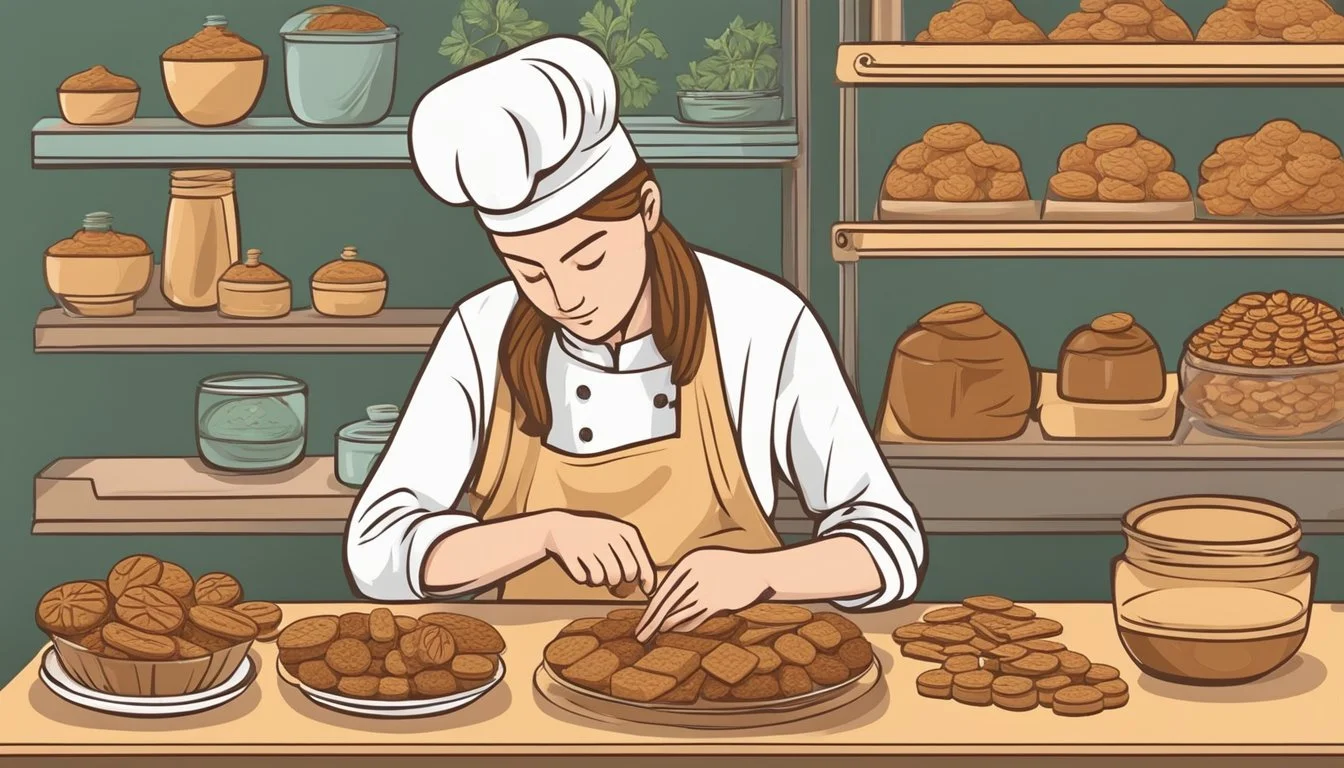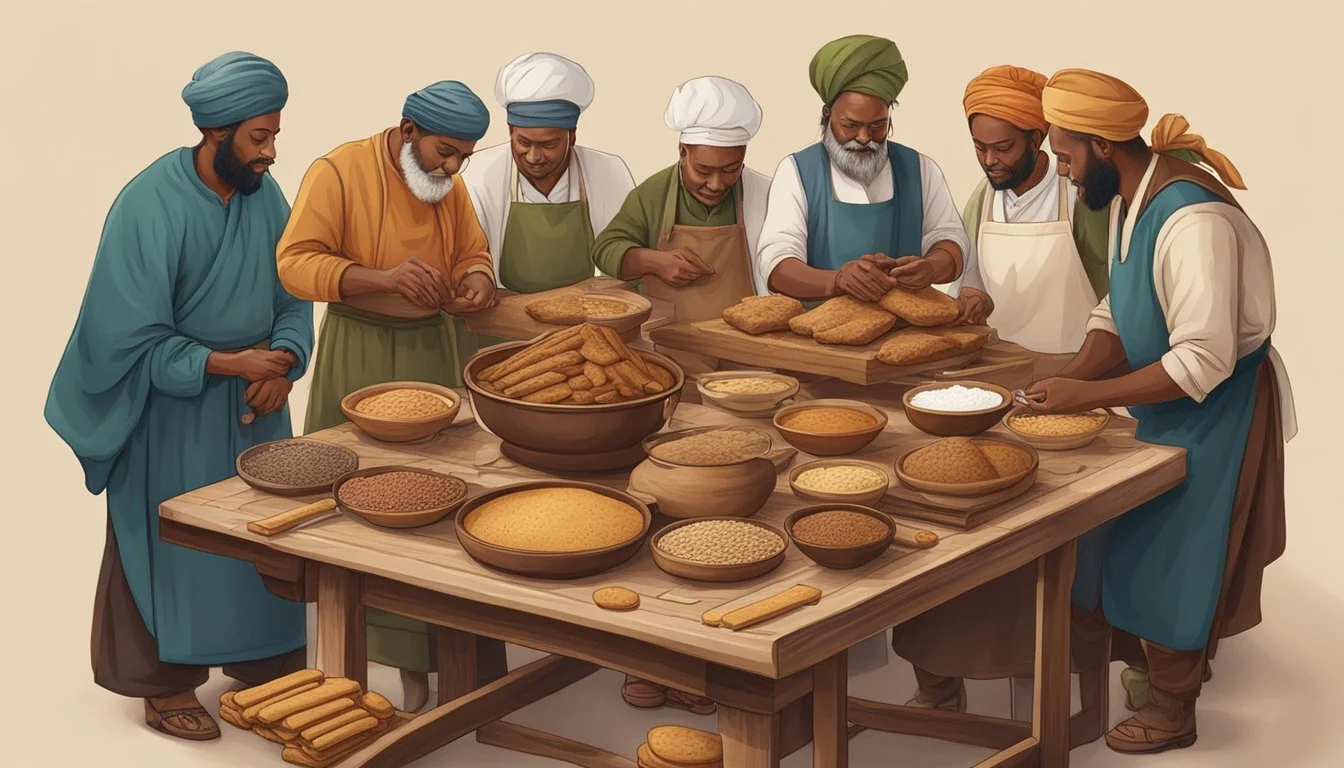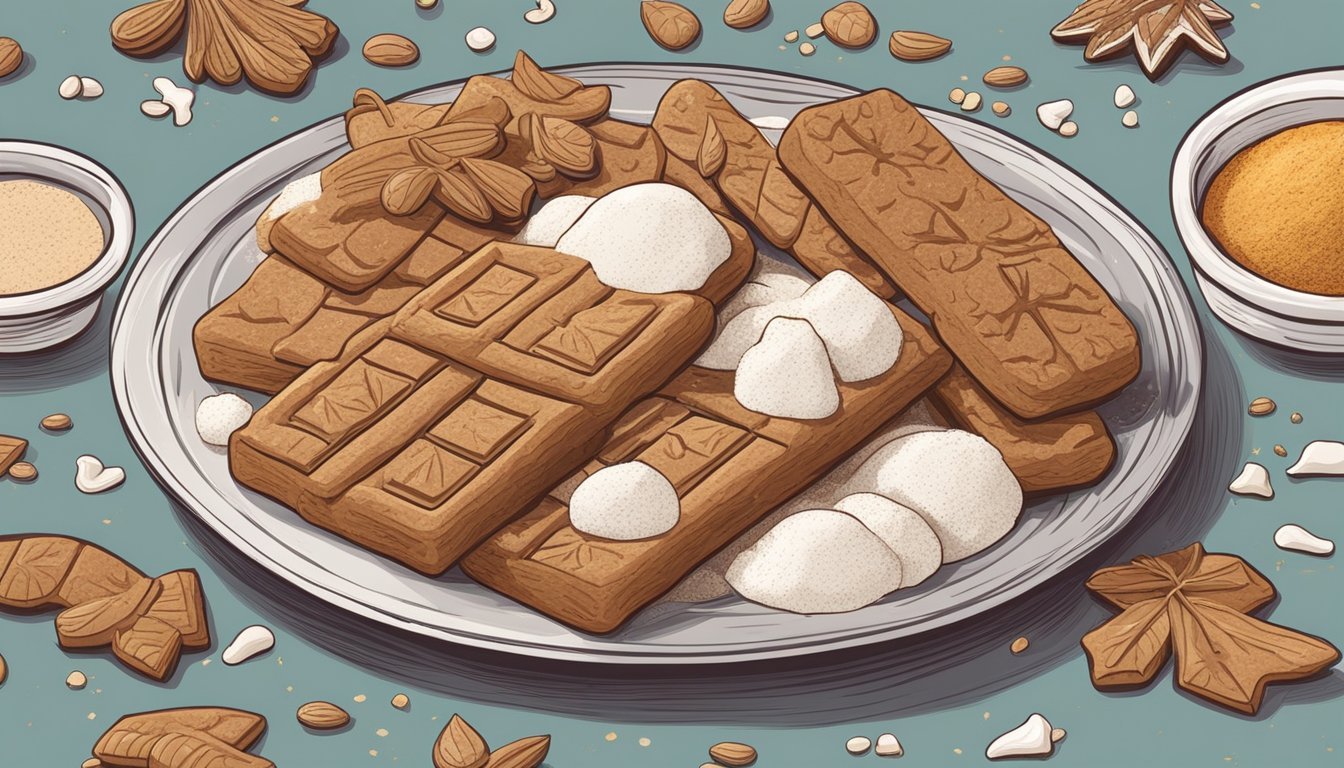Are Speculaas Vegan?
Unveiling the Truth About This Dutch Treat
Speculaas, traditionally known as Dutch spiced cookies, are a staple treat particularly enjoyed during the festive Sinterklaas season. These cookies are typically characterized by their distinct blend of spices like cinnamon, nutmeg, cloves, and ginger. While the original recipe for speculaas includes butter and sometimes milk, there is a growing interest in whether these spiced cookies can align with vegan dietary preferences.
The vegan diet excludes all animal products, including dairy and eggs, which are common in many baking recipes. As a result, vegan variations of speculaas have emerged, utilizing plant-based alternatives to traditional ingredients. Vegan speculaas often employ substitutes such as flax eggs—a mixture of flaxseed meal and water—to mimic the binding properties of eggs, and plant-based butters or oils in place of dairy butter.
Given the adaptability of speculaas recipes to cater to vegan requirements without compromising on flavor or texture, these cookies can indeed be enjoyed by vegans. The key is to carefully select ingredients that adhere to vegan standards, ensuring that the integrity of the original speculaas is maintained while respecting vegan principles. Such considerations make it possible for this beloved cookie to be inclusive to a broader audience.
Overview of Speculaas
Speculaas are a type of spiced shortcrust biscuit, traditionally baked around the holiday season in the Netherlands, Belgium, and some parts of Germany. Originating from Dutch and Belgian food culture, these biscuits are closely associated with Christmas and St. Nicholas Day festivities. The name "speculaas" is derived from the Latin word 'speculum', which means mirror, and reflects the fact that the biscuits often carry a mirrored imprint from their molds.
Ingredients and Flavors:
Key Spices: A blend of cinnamon, nutmeg, cloves, ginger, cardamom, and sometimes white pepper.
Texture: Ranges from thin and crispy to thicker and softer variations.
Vegan Variations: Traditional recipes include butter and sometimes egg, but vegan versions substitute these with plant-based alternatives.
Cultural Significance:
Netherlands and Belgium: Considered a staple during the holiday season.
Sinterklaas Celebration: Especially popular during Sinterklaas or St. Nicholas Day on December 5th/6th, celebrating the feast of St. Nicholas.
Molded Designs: Often intricately shaped with molds that reflect various images, such as windmills, animals, and historical figures.
In summary, speculaas are more than just cookies; they are a cultural emblem of the Dutch and Belgian holiday spirit, relished for their unique spice blend and festive significance.
Veganism and Speculaas
Speculaas, a traditional European spiced cookie commonly enjoyed during the holidays, typically contains several non-vegan ingredients, such as butter and eggs. Vegans avoid these due to ethical and health concerns associated with animal products. However, modifications can be made to render speculaas vegan-friendly.
Ingredients:
Butter: A staple in traditional speculaas can be replaced with vegan butter or margarine. Brands offering these substitutes formulate their products to mirror the taste and baking qualities of dairy butter.
Eggs: Usually acting as a binding agent in the dough, they can be substituted with various plant-based options. Common egg alternatives include flaxseed or chia eggs, where seeds are mixed with water to form a gel-like consistency.
Almond flour is naturally vegan and a common ingredient in speculaas, enhancing the cookie's characteristic nutty profile while fitting seamlessly into a vegan diet. When purchasing, one should ensure that no cross-contamination has occurred if allergens or dietary restrictions are a concern.
For those seeking complete plant-based alternatives, a typical speculaas spice mix—which includes cinnamon, nutmeg, cloves, and ginger—is inherently vegan.
Consideration for Vegan Bakers:
Confirm that any pre-made speculaas spice mix is free from animal-derived additives.
Choose vegan-certified or plant-based labels when buying substitutive products to ensure compatibility with vegan standards.
By carefully selecting ingredients and preparing them with intention, speculaas can be enjoyed in a manner consistent with vegan dietary practices.
Traditional Ingredients of Speculaas
Speculaas, a traditional cookie, is famous for its distinctive blend of spices and other key ingredients that result in a rich flavor and satisfying texture.
Key Spices in Speculaas
Cinnamon: The dominant spice, providing warmth.
Nutmeg: Adds depth to the flavor profile.
Cardamom: Imparts a slightly sweet, floral note.
Cloves: Contribute a pungent, aromatic touch.
White Pepper: Introduces a subtle heat.
Anise: Offers a hint of licorice flavor.
Ginger: Delivers a spicy kick.
These spices may come together as a pre-made speculaas spice mix that can be used in various recipes.
Non-Spice Ingredients
Butter: Often used for a rich taste.
Sugar: White or brown sugar for sweetness.
Flour: Typically, plain flour forms the base.
Egg: May be included to bind the ingredients.
Texture and Consistency Components
Butter and Flour: The ratio of these affects whether the cookies are crispy or soft.
Baking Soda/Powder: Agents that aid in achieving the desired rise and texture.
Decorative and Aesthetic Elements
Traditional speculaas cookies are often embossed with images using a stamp or mold; popular designs include the Dutch windmill.
Sliced almonds and icing can serve as both decoration and flavor enhancers.
The Baking Process
Speculaas dough is rolled out, often with a rolling pin, and shaped using cookie cutters. The oven temperature and timing are key to reaching the perfect crispiness or softness.
Flavor Enhancers and Variations
Additional ingredients for enhanced flavor:
Vanilla Extract: Adds a subtle, sweet aroma.
Ground Almonds: Can be included for a nutty taste.
Speculoos: A popular biscuit spread derived from speculaas cookies, often used in various desserts.
The exact composition of the speculaas spice mix and additional flavors might vary by region or personal preference.
Vegan Speculaas: How-To
Making vegan speculaas involves selecting appropriate plant-based alternatives for traditional non-vegan ingredients and incorporating effective techniques for mixing, kneading, baking, and storing to ensure the final product preserves the classic speculaas texture and flavor.
Selecting Vegan Alternatives
For a successful vegan speculaas, one must choose substitutes that mimic the properties of their non-vegan counterparts. Vegan butter is the preferred replacement for dairy butter, providing the necessary fat to the dough without the use of animal products. Instead of regular milk, a variety of plant-based milks—such as almond, soy, or oat milk—can be used. When choosing a binder to replace eggs, options include aquafaba or flaxseeds mixed with water. Almond flour can be used in combination with all-purpose flour to enhance the nutty flavor typical of speculaas.
Mixing and Kneading Techniques
To create the dough, one should use a spatula or an electric mixer to thoroughly blend the vegan butter, sugar, and chosen plant-based milk. Spices, baking powder, and a pinch of salt are whisked in next. After combining the wet ingredients, gradually add the flour mixture and knead until a consistent cookie dough forms. The dough should be wrapped in plastic wrap and allowed to rest in the refrigerator, ensuring the spices fully infuse their flavor.
Baking and Cooling
Preheat the oven to 350°F (175°C) and line a baking tray with parchment paper. Roll out the rested dough using a rolling pin until it reaches the desired thickness. If the dough cracks, dampen it slightly to smooth it out. Cut the dough into shapes or press into molds and place on the prepared tray. Bake until the speculaas are golden brown and firm. Once removed from the oven, they should be transferred to a cooling rack to prevent them from becoming soggy.
Storing Vegan Speculaas
To preserve freshness, speculaas should be stored in an airtight container. Glass jars or plastic containers are suitable as they protect the cookies from moisture and keep them crisp. If a container is not available, tightly wrapping the cookies in plastic wrap can also be an effective temporary solution. Stored properly, vegan speculaas can retain their quality for several weeks.
Pairings and Serving Suggestions
Speculaas cookies, with their rich spices and crisp texture, are wonderfully versatile and can be paired with a variety of beverages and desserts. Here are some pairing suggestions:
Beverage Pairings:
Coffee: The bold flavor of coffee complements the spicy notes of speculaas. A robust espresso or a creamy latte makes excellent choices.
Tea: For tea enthusiasts, a cup of black tea or chai with its own blend of spices harmonizes with the cookies' flavors.
Hot Chocolate: A comforting cup of hot chocolate pairs beautifully, especially when topped with whipped cream, offering a contrast to the crisp biscuit.
Dessert Parings:
With Ice Cream: Speculaas can serve as a crunchy topping on a scoop of vanilla or cinnamon ice cream.
As Pie Crust: Crumble the cookies to create a flavorful base for cheesecakes or custard pies.
Cheese Platter: It can accompany a selection of cheeses, particularly those with caramel notes like aged gouda.
Speculaas cookies can be enjoyed in various forms and pairings, ensuring a delightful taste experience.
Cultural Significance of Speculaas
Speculaas, a staple in Dutch and Belgian culinary traditions, is intricately woven into Europe's festive calendar. It is especially prominent during the holiday season, resonating with warm, spiced flavors that embody the essence of winter celebrations.
In the Netherlands and Belgium, these cookies are synonymous with Sinterklaas (St. Nicholas Day), celebrated on December 5th and 6th respectively. The eve of this festival, known as Sinterklaasavond, sees families enjoying speculaas as part of their festivities. Here's how the cookie integrates with cultural practices:
Symbol of Tradition: Speculaas molds often depict images of St. Nicholas, reinforcing its role in the saint's day festivities.
Gift-Giving: They are commonly gifted to children, symbolizing the generosity of St. Nicholas.
Country Holiday Speculaas Role Netherlands Sinterklaas (Dec 5th) Traditionally consumed; often shaped into figures associated with the Saint. Belgium St. Nicholas Day (Dec 6th) Integral to celebrations; shared among families.
Furthermore, speculaas cookies have become a Christmas staple across Germany and other European regions, expanding their cultural significance beyond the Low Countries. The spices—cinnamon, nutmeg, cloves, ginger, and cardamom—hark back to the medieval spice trade, embedding a rich history within each bite.
The adaptability of speculaas, having been adopted into vegan recipes, demonstrates its evolving role in contemporary dietary practices. Yet, the core elements that comprise its identity—crisp texture, distinct shape, and evocative flavor—remain a testament to its enduring cultural impact during the holiday season.
Dietary Information and Allergens
Traditional speculaas cookies are typically made with ingredients that include butter (a dairy product), eggs, and sometimes almonds, which are common allergens and non-vegan ingredients. For individuals following a vegan diet or those with specific food allergies, consumption of standard speculaas may not be suitable.
A vegan version of speculaas can be made by substituting animal-based ingredients with plant-based alternatives. The common substitutes are outlined below:
Butter: can be replaced with plant-based butter or oils to maintain the rich flavor and texture.
Eggs: are often substituted with flaxseed meal, apple sauce, or commercial egg replacers to bind the ingredients together.
Milk: is not typically a core ingredient in speculaas, but when present, can be replaced with plant-based milk like almond, soy, or oat milk.
Allergen Information
Allergen Traditional Speculaas Vegan Speculaas Egg Commonly Present Replaced/Substituted Milk Often Present Replaced/Substituted Almonds May Contain May Contain
Those with nut allergies should be aware that almonds are a typical component in speculaas spice mix or as a decorative topping. Even in vegan versions, almonds or other nut-based products for flavor and texture might still be present.
In terms of nutrition, while it is common to assume that vegan products are healthier, this is not always the case. Vegan speculaas may still be high in sugars and fats, so those considering dietary restrictions for health reasons should examine the nutritional profile of the vegan substitutes used.
Readers are urged to always check the labeling of speculaas for detailed allergen and nutritional information, whether purchasing from stores or when making them at home. Manufacturers might produce vegan speculaas in facilities that handle dairy, eggs, and nuts, therefore cross-contamination is possible and should be considered by those with severe allergies.
Customizing Speculaas for Dietary Restrictions
Speculaas, a traditional Dutch biscuit, often contains butter and eggs. Adapting the recipe for vegan diets involves substituting these ingredients without sacrificing the distinctive spiced flavor and crisp texture.
Butter Substitutes: Vegan butter is a direct replacement for dairy butter. It is designed to emulate the taste and texture of butter while being free from animal products. When selecting a substitute, one should ensure that it has a similar fat content to traditional butter for best results.
Egg Replacements: Eggs can be replaced with "flax eggs," a combination of ground flaxseed and water. The resulting mixture binds the ingredients together, similar to the role eggs play in the traditional recipe.
Almond Flour: Some recipes incorporate almond flour, which can add a rich, nutty flavor and tender crumb to the cookies. It can serve as a gluten-free option, complementing the spices nicely.
Here is a brief guide to replacing key ingredients in Speculaas:
Traditional Ingredient Vegan Substitute Notes Butter Vegan butter (e.g., Earth Balance) Maintain a similar fat content for the best texture. Eggs Flax eggs (1 flax egg = 1 tbsp ground flax + 3 tbsp water) Mix well and allow to sit for a few minutes before use. Flour Almond flour Can be used partially in place of wheat flour for a gluten-free version.
For sweeteners, one can opt for agave syrup or other plant-based sweeteners to avoid refined sugars. By making these alterations, bakers can create a speculaas that adheres to vegan standards without forfeiting the delightful flavors that define this cherished cookie.
Buying Guide for Speculaas
When searching for speculaas, it's important to be informed about what to look for, especially if one is seeking a vegan option. Speculaas is a traditional Dutch and Belgian biscuit, particularly popular during the holiday season. They are often sought after as gifts and come in charming containers that capture the festive spirit.
Supermarkets and Specialty Stores:
Many supermarkets offer speculaas, especially in the international aisle.
Health food stores or specialty stores may carry vegan versions.
Check labels for non-vegan ingredients like butter or eggs.
Ingredients to Look For:
Vegan butter or oil as a substitute for dairy butter.
Plant-based milk instead of cow's milk.
If it contains eggs, look for a flax egg or other vegan binders.
Packaging and Presentation:
Speculaas may come in decorative tins or boxes, which can be reused.
Ensure the container is sealed properly to maintain freshness.
Gift Considerations:
If buying speculaas as a gift, ensure that the labeling clearly indicates it's vegan.
For those with diet restrictions, confirm the absence of gluten if it's gluten-free speculaas.
When purchasing speculaas, check the ingredient list to ensure the product meets vegan standards. They should not include dairy or any animal-derived products. During festive seasons, vegan speculaas may be more readily available, but it's always wise to shop early to avoid disappointment. Whether for oneself or as a gift, selecting vegan speculaas can be a delightful way to embrace tradition while adhering to a plant-based lifestyle.
Historical Background of Speculaas
Speculaas, known for being spiced Dutch cookies, have a significant place in the culinary history of Europe. Originating primarily in the Netherlands and Belgium, speculaas have traversed geographical boundaries and are appreciated for their unique blend of flavors.
In the Netherlands, these cookies are traditionally associated with the feast of St Nicholas, enjoyed around early December. Their fundamental ingredients include wheat flour, brown sugar, butter, and a distinctive mix of Speculaas spices—typically cinnamon, nutmeg, cardamom, cloves, and ginger. The specific spice blend imparts a characteristic warmth and aroma, making the cookies synonymous with festive seasons.
Belgians have contributed their own twist to speculaas, historically adapting the recipe to their regional ingredient availability. Notably known in Belgium as 'Speculoos,' their version originally was made with less or no spices, distinguishing it from the Dutch variant. Nonetheless, both Belgian and Dutch bakers share a deep-rooted tradition of crafting these cookies with meticulous detail, often pressing them into wooden molds featuring intricate designs before baking.
Speculaas are also popular in parts of Germany, particularly in Westphalia and Rhineland, as well as in Luxembourg and northern France, indicating their widespread favor across European borders. The historical spread of the Dutch trade and colonial influence can be observed in Speculaas' popularity in regions like Indonesia, testifying to the cookie's long journey from European festive treat to a globally enjoyed delicacy.
The proliferation of speculaas throughout various European regions reflects not only trade patterns but also cultural exchanges. While the basic recipe is shared, regional variations have emerged, enriched by the availability of local ingredients and cultural preferences.
Additional Resources
Recipe Collections
For those interested in crafting their own vegan speculaas cookies at home, there are numerous recipes available online. Recipe platforms and blogs typically offer a variety of versions, including those that are gluten-free or use alternate sweeteners. Readers are encouraged to search for recipes that specifically mention being vegan to ensure they align with dietary preferences.
Newsletters and Blogs
Subscribers to newsletters or followers of food blogs that focus on vegan baking can find an assortment of homemade speculoos cookie recipes. They are a helpful source of tips and variations on the classic speculaos, often incorporating different spice mixes like pumpkin spice for a seasonal twist.
Spice Mixes
For enthusiasts wanting to achieve the authentic flavor, crafting a homemade speculaos spice mix is key. The mix often includes cinnamon, nutmeg, cloves, and ginger. Specialty spice stores or online shops may carry ready-made speculaos spice blends for convenience.
Resource Type Description Recipes Curated collections from various websites offering step-by-step instructions. Newsletters Regular updates from vegan baking communities with tips and recipes. Blogs Personal accounts and experimentation with vegan speculoos baking. Spice Mixes Commercial or recipes for creating the classic speculaos flavor profile.
Readers should verify that all ingredients used are in fact vegan, as some traditional speculaas recipes may include animal-derived components. With these resources, they can enjoy vegan speculoos cookies that don't compromise on taste or tradition.
Conclusion
Traditional speculaas cookies are not vegan due to ingredients like butter and eggs. However, many recipes have been adapted to cater to a vegan diet. These adaptations use plant-based substitutes to achieve a similar taste and texture to the original.
Key Components in Vegan Speculaas:
Fats: Vegan butter or oils replace dairy butter.
Binders: Flax or chia eggs substitute chicken eggs.
Sweeteners: Agave syrup or other vegan sugars are used instead of white sugar.
Essential Spices:
Cinnamon
Nutmeg
Ground Ginger
Cardamom
Allspice
These spices give the cookies their signature warm, spiced flavor.
Vegan Speculaas Recipe Tips:
Blend the fat and sweetener until creamy.
Mix in the binder followed by the dry ingredients.
Chill the dough for easier handling.
Bake at around 180°C (350°F) until golden brown.
It is evident that with careful selection of ingredients, speculaas cookies can be made vegan without compromising on flavor. Those following a vegan lifestyle can enjoy this spiced Dutch delicacy during the holiday season or anytime, really. Whether using a hand mixer or by hand, creating these cookies can be a delightful and inclusive baking endeavor.











